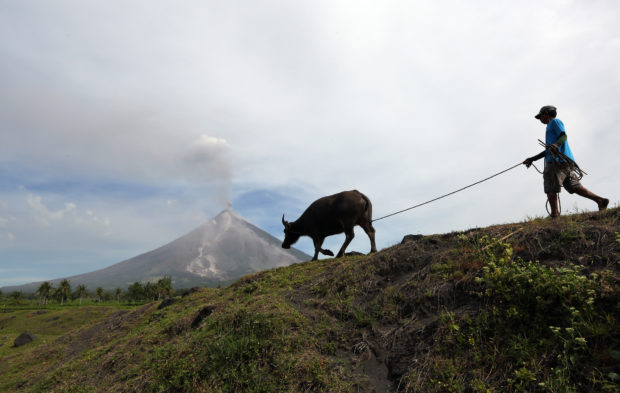
FARM LIFE GOES ON A farmer tends to his farm at Barangay Busay, Daraga, Albay province, even as Mt. Mayon continues to show signs of restiveness. —NIÑO JESUS ORBETA
LEGAZPI CITY—The lava in one of the channels on Mt. Mayon has advanced an additional 300 meters, a sign that the restiveness of the volcano is not waning despite a lull over the past several days, the Philippine Institute of Volcanology and Seismology (Phivolcs) said on Sunday.
From 4 kilometers on Friday, the lava has flowed to 4.3 km along the Bonga-Buyuan Gully toward Legazpi City, Phivolcs said.
The lava flow in the Miisi Gully toward Daraga town has reached 3.2 km.
Mariton Bornas, chief of Phivolcs’ Volcano Monitoring and Eruption Prediction division, said she could not determine whether the lava flow would extend to up to 6 km like it did on Dec. 29, 2009.
“It is hard to say because the lava could also split and branch out to other channels,” Bornas told the Inquirer.
She said her division’s calculations showed that the average daily outflow of lava was 2 million cubic meters.
Sent home
The lull prompted the authorities to send home on Friday some 60,000 people who had taken shelter in evacuation centers in Albay province after Phivolcs raised Alert Level 4 (hazardous eruption imminent) on Jan. 22, when Mayon spewed ash columns 5 km into the air and vomited lava fountains.
The evacuees, about 70 percent of the 84,543 people crowding various evacuation camps in Albay, lived inside the 9-km extended danger zone around the volcano that the provincial government had declared a “buffer zone.”
Claudio Yucot, Office of Civil Defense-Bicol director, said sending home the evacuees was meant to decongest the 70 evacuation shelters in Albay.
Eruptive stage
Ed Laguerta, Phivolcs resident volcanologist here, said lava fountains and pyroclastic flows due to lava collapse and tremors signified that the volcano’s eruptive stage had been sustained.
Phivolcs reiterated its advisory to the public to desist from entering the 8 km-radius danger zone, as Alert Level 4 remained in effect.
Scenarios stand
“If you look at those eruptions, those are not very tall columns, at most 5 kilometers. And this essentially would mean that the lava flow or the ‘uson’ (pyroclastic density currents) are confined within the 6-km danger zone,” Phivolcs Director Renato Solidum Jr. said of Mayon’s restive state.
“Essentially, the activities are Strombolian activities. That is not the most explosive eruption,” he added.
Strombolian eruptions, wherein lava fountaining and lava effusion can be observed, are minor eruptions compared with explosive Vulcanian, Pelean and Plinian eruptions.
Vulcanian, Pelean, Plinian
The 1968 and the second phase of the 1984 eruptions were Vulcanian in nature, while the 1814 eruption that killed 1,200 Albayanos was a Plinian eruption.
In a Vulcanian eruption, magma and magmatic gas are released high into the atmosphere by a great force resulting in large eruption clouds.
In a Pelean eruption, glowing avalanches made of dense, hot gases are present along with the large amount of gas from the magma that causes pyroclastic materials.
In the violent Plinian eruption, there is a larger quantity of pyroclastic flow with pumice and the eruption collapses the top of the cone resulting in a caldera.
Solidum said the scenarios Phivolcs were looking at remained.
One scenario is that the Strombolian activity would transform into a Vulcanian activity just like in the 1968, 1984, 2000 and 2001 eruptions after a visual lull in Mayon’s activities.
Alert Level 5
“The climactic part of those eruptions is Alert Level 5. Those are very tall columns and extensive ashfall and pyroclastic flows due to column collapse,” Solidum said.
Ash columns may collapse if they become dense in the air.
In an Alert Level 5 (hazardous eruption underway) scenario, the sustained eruption produces pyroclastic density currents that reach farther down, according to the Phivolcs chief.
So far, Mayon has generated short and short-lived pyroclastic flows.
“The ideal thing is that people should be evacuated before the occurrence of Alert Level 5,” Solidum said. —WITH A REPORT FROM MAR S. ARGUELLES, INQUIRER SOUTHERN LUZON